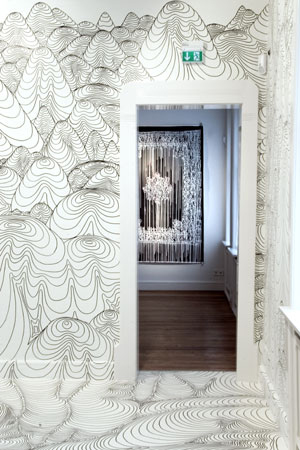Recently, I came across these designs by Heike Weber. And while they may already be astounding just the way they are, I was even more amazed when I read the description of the images (which I usually don’t do), and I found that they’re drawn with permanent markers –crazy brilliant, yes. I wonder, though, who wouldn’t go crazy when living in a house decorated like this? Perhaps perception psychology people –possibly.
So how did this artist, and many others, create the illusion of seemingly alien species sticking out of walls, or the whirlpool in the middle of the room? Texture gradients. Texture gradient is the pattern of the surface we see. This pattern seems more compact when it is further away, than when it is near.

In this picture, we see a regular tiled floor. The lines marking the tiles at the end of the room seem to be closer to each other than those that are near us, even though we know that the tiles are all the same size of square. The same principle is applied in the artwork below.

Here we have another example of using texture gradient to create an illusion of distance. The “mountains” that seem
farther have lines drawn closer to each other than those that seem nearer.Another factor we see here is occlusion, where an object covers another object, making the covering object seem nearer than the covered. This is easily observed in real life. Let’s say there’s a mango in front of you, and I put an apple in front of you, covering the mango. You would probably say that the apple is closer to you than the mango. The same thing goes here: the “mountains” that are nearer partially cover the “mountains” that are farther.
In the same picture, we can see another cue for determining the “mountains’” relative distance: relative height. The “mountains” that seem farther have their bases higher than the “mountains” that seem nearer. If you look at the wall as just a plain, flat wall, the foot (or feet?) of some of the “mountains” (those that seem farther away) are above other “mountains” (those that seem closer).
Using these cues, we can create illusions, making the room seem bigger or smaller than it actually is. Let’s take a look at the television in the picture below.We can see that it seems very distant, and we have texture gradient to thank for that. But this is not the only factor affecting how we perceive the television’s distance. Notice how the photographer loves capturing the ground and not the ceiling. It’s probably because it’s easier to take photographs from the floor, but it could also be possibly because the ground plays a huge part in perceiving distance.
 A long, long time ago, a man called Alhazen said that there has to be an array of “ordered, continuous” bodies between the object and the viewer’s eyes in order for him to accurately perceive the distance between him and that object (as cited in Bien, Braunstein, and Andersen, 2006). In the pictures above, the floor is our “ordered, contiuous” body. It has been found that even when given a ceiling, people still preferred to make judgments of distance according to the ground -or the floor (Bien, Braunstein, & Andersen, 2006). The scientists who found out about this referred to the phenomenon as the ground dominance effect. They also found that when there were two side walls, instead of the ceiling and the floor, people did not prefer either wall over the other, emphasizing more the role of the ground in our perceiving distance.
A long, long time ago, a man called Alhazen said that there has to be an array of “ordered, continuous” bodies between the object and the viewer’s eyes in order for him to accurately perceive the distance between him and that object (as cited in Bien, Braunstein, and Andersen, 2006). In the pictures above, the floor is our “ordered, contiuous” body. It has been found that even when given a ceiling, people still preferred to make judgments of distance according to the ground -or the floor (Bien, Braunstein, & Andersen, 2006). The scientists who found out about this referred to the phenomenon as the ground dominance effect. They also found that when there were two side walls, instead of the ceiling and the floor, people did not prefer either wall over the other, emphasizing more the role of the ground in our perceiving distance.So what could be the explanation for this ground dominance effect? Another scientist named Gibson, suggested more than 50 years ago that the ground is universal, and that it supports most of the objects in the environment, as well as the movement of animals (as cited in Bien, Braunstein, & Andersen, 2006). This means that because the ground is everywhere (unless perhaps you are in outer space), we have adapted to using it as basis for judging distance, as opposed to the ceiling –which is, of course not everywhere (have you tried using the sky?). when the information given by the ceiling and the ground oppose each other, people would still use the ground as basis.
References:
Bien, Z., Braunstein, M. L., & Andersen, G. J. (2006). The ground dominance effect in the perception of relative distance in 3-D scenes is mainly due to characteristics of the ground surface. Perception & psychophysics , 68 (8), 1297-1309.
Goldstein, E. B. (2007). Sensation and Perception (7th Eds.).
Belmont, CA: Wadsworth. Heike Weber bumbumbum
-At

No comments:
Post a Comment